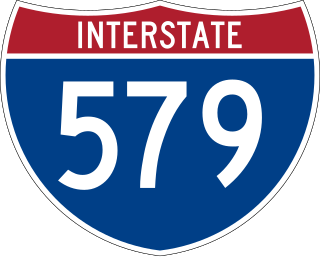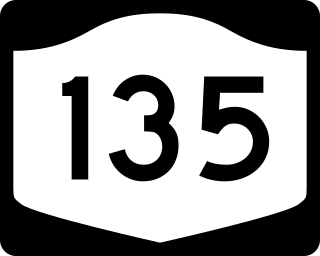
Interstate 87 (I-87) is a 333.49-mile-long (536.70 km) north–south Interstate Highway located entirely within the US state of New York. I-87 is the main highway that connects New York City and Montreal. The highway begins at exit 47 off I-278 in the New York City borough of the Bronx, just north of the Robert F. Kennedy Bridge and Grand Central Parkway. From there, the route runs northward through the Hudson Valley, the Capital District, and the easternmost part of the North Country to the Canada–United States border in the town of Champlain. At its north end, I-87 continues into Quebec as Autoroute 15 (A-15). I-87 connects with several regionally important roads: I-95 in New York City, New York State Route 17 near Harriman, I-84 near Newburgh, and I-90 in Albany. The highway is not contiguous with I-87 in North Carolina.

The Hutchinson River Parkway is a controlled-access parkway in southern New York in the United States. It extends for 18.71 miles (30.11 km) from the Bruckner Interchange in the Throggs Neck section of the Bronx to the New York–Connecticut state line at Rye Brook. The parkway continues south from the Bruckner Interchange as the Whitestone Expressway (Interstate 678) and north into Greenwich, Connecticut, as the Merritt Parkway. The roadway is named for the Hutchinson River, a 10-mile-long (16 km) stream in southern Westchester County that the road follows alongside. The river, in turn, was named for English colonial religious leader Anne Hutchinson.

Interstate 579 (I-579) is a north–south Interstate Highway entirely within Pittsburgh, Pennsylvania. The highway is 2.73 miles (4.39 km) long. I-579 is also known as the Crosstown Boulevard since it crosses the backside of Downtown Pittsburgh.

Interstate 287 (I-287) is an auxiliary Interstate Highway in the US states of New Jersey and New York. It is a partial beltway around New York City, serving northern New Jersey and the counties of Rockland and Westchester in New York. I-287, which is signed north–south in New Jersey and east–west in New York, follows a roughly horseshoe-shaped route from the New Jersey Turnpike (I-95) in Edison, New Jersey, clockwise to the New England Thruway (I-95) in Rye, New York, for 98.72 miles (158.87 km). Through New Jersey, I-287 runs west from its southern terminus in Edison through suburban areas. In Bridgewater Township, the freeway takes a more northeasterly course, paralleled by US Route 202 (US 202). The northernmost part of I-287 in New Jersey passes through mountainous surroundings. Upon entering New York at Suffern, I-287 turns east on the New York State Thruway (I-87) and runs through Rockland County. After crossing the Hudson River on the Tappan Zee Bridge, I-287 splits from I-87 near Tarrytown and continues east through Westchester County on the Cross Westchester Expressway until it reaches the New England Thruway. Within New Jersey, I-287 is maintained by the New Jersey Department of Transportation (NJDOT), and, within New York, it is maintained by the New York State Thruway Authority (NYSTA).

The Taconic State Parkway is a 104.12-mile (167.56 km) limited-access parkway between Kensico Dam and Chatham, the longest in the U.S. state of New York. It follows a generally north–south route midway between the Hudson River and the Connecticut and Massachusetts state lines, much of its upper section along the westernmost flank of the Taconic Mountains. It is open only to passenger vehicles, as with other parkways in New York, and maintained by the state Department of Transportation (NYSDOT), the fourth agency to have that responsibility.

The Henry Hudson Parkway is a 10.95-mile (17.62 km) controlled-access parkway in New York City. The southern terminus is in Manhattan at 72nd Street, where the parkway continues south as the West Side Highway. It is often erroneously referred to as the West Side Highway throughout its entire course in Manhattan. The northern terminus is at the Bronx–Westchester county boundary, where it continues north as the Saw Mill River Parkway. All but the northernmost mile of the road is co-signed as New York State Route 9A (NY 9A). In addition, the entirety of the parkway is designated New York State Route 907V (NY 907V), an unsigned reference route.

Interstate 684 (I-684) is a 28.53-mile (45.91 km) auxiliary Interstate Highway in the state of New York in the United States. There is also a short portion in Connecticut with no junctions. The highway connects I-84 in Southeast with I-287 in Harrison, primarily serving commuter traffic to and from the northern suburbs of the New York metropolitan area. Most of the route is in northern Westchester County. The route of the highway was originally designated as part of I-87 from 1968 to 1970. The first section of the roadway opened to traffic in October 1968, and the final segment was completed in December 1974.

The Saw Mill River Parkway is a limited-access parkway that extends for 29.83 miles (48.01 km) through Westchester County, New York, in the United States. It begins at the border between Westchester County and the Bronx, as the continuation of the Henry Hudson Parkway leaving New York City, and heads generally northeastward to an interchange with Interstate 684 (I-684). At its north end, the parkway serves as a collector/distributor road as it passes east of the hamlet of Katonah. The parkway is named for the Saw Mill River, which the highway parallels for most of its length.

New York State Route 22 (NY 22) is a north–south state highway that parallels the eastern border of the U.S. state of New York, from the outskirts of New York City to the hamlet of Mooers in Clinton County near the Canadian border. At 337 miles (542 km), it is the state's longest north–south route and the third longest state route overall, after NY 5 and NY 17. Many of the state's major east–west roads intersect with, and often join, NY 22 just before crossing into the neighboring New England states, where U.S. Route 7 (US 7), which originally partially followed NY 22's alignment, similarly parallels the New York state line.

The Sprain Brook Parkway is a 12.65-mile (20.36 km) controlled-access parkway in Westchester County, New York, United States. It begins at an interchange with the Bronx River Parkway in the city of Yonkers, and ends at the former site of the Hawthorne Circle, where it merges into the Taconic State Parkway. The parkway serves an alternate to the Bronx River Parkway, boasting an interchange connection through western Westchester with Interstate 287. New York's Department of Transportation (NYSDOT) refers to it internally as New York State Route 987F (NY 987F), an unsigned reference route.

New York State Route 1A (NY 1A) was a north–south state highway mostly located within New York City. It extended for just under 18 miles (29 km) from an intersection with NY 27 near the Holland Tunnel in Lower Manhattan to an interchange with U.S. Route 1 (US 1) just north of the New York City line in the Westchester County village of Pelham Manor. In Manhattan and the South Bronx, NY 1A used several surface streets to traverse the boroughs, including a handful of one-way roads. At the Bronx River, it began to follow limited-access highways, specifically the Bruckner Expressway and the Hutchinson River Parkway.

Interstate 95 (I-95) is part of the Interstate Highway System and runs from Miami, Florida, to the Canada–United States border near Houlton, Maine. In the US state of New York, I-95 extends 23.50 miles (37.82 km) from the George Washington Bridge in New York City to the Connecticut state line at Port Chester. The George Washington Bridge carries I-95 across the Hudson River from New Jersey into New York City. There, I-95 runs across Upper Manhattan on the Trans-Manhattan Expressway for 0.81 miles (1.30 km) through Washington Heights. It continues east across the Harlem River on the Alexander Hamilton Bridge and onto the Cross Bronx Expressway. In the Bronx, I-95 leaves the Cross Bronx at the Bruckner Interchange, joining the Bruckner Expressway to its end. North of the interchange with Pelham Parkway, it then continues northeast via the New England Thruway out of New York City into Westchester County and to the Connecticut state line, where I-95 continues on the Connecticut Turnpike.

The Cross County Parkway (CCP) is a 4.46-mile (7.18 km) controlled-access parkway in lower Westchester County, New York, in the United States. The parkway is a critical east–west connection throughout Westchester, having full interchanges with every major north–south highway in southern Westchester with the exception of Interstate 95. Among its junctions, it has access to the New York State Thruway mainline. The western terminus is at the Saw Mill Parkway in Yonkers. The eastern terminus is at the Hutchinson River Parkway in Eastchester.

New York State Route 100 (NY 100) is a major north–south state highway in Westchester County, New York, in the United States. It begins parallel to Interstate 87 (I-87) at a junction with the Cross County Parkway in the city of Yonkers and runs through most of the length of the county up to U.S. Route 202 (US 202) in the town of Somers. NY 100 was designated as part of the 1930 renumbering of state highways in New York. Prior to becoming a state road, various sections of NY 100 were part of several important early roads in the county.

New York State Route 117 (NY 117) is a 15.23-mile (24.51 km) state highway in Westchester County, New York, in the United States. The southern terminus of the route is at an intersection with U.S. Route 9 (US 9) north of the village of Sleepy Hollow. The northern terminus is at an interchange with the Saw Mill River Parkway just south of Interstate 684 (I-684), south of Katonah, a hamlet in the town of Bedford. NY 117 meets the Taconic State Parkway in Pleasantville and parallels the Saw Mill Parkway from Pleasantville to Bedford.
The Central Westchester Parkway is a 1.01-mile (1.63 km) controlled-access parkway in Westchester County, New York, in the United States. It runs from exit 7 of the Cross Westchester Expressway (I-287) to New York State Route 22 (NY 22). The road has two intermediate exits and is maintained by Westchester County as County Route 150.

U.S. Route 1 (US 1) is a part of the U.S. Highway System that extends from Key West, Florida, to the Canada–United States border at Fort Kent, Maine. In the U.S. state of New York, US 1 extends 21.54 miles (34.67 km) from the George Washington Bridge in Manhattan to the Connecticut state line at Port Chester. It closely parallels Interstate 95 (I-95) for much of its course and does not serve as a major trunk road within the state. It is not concurrent with any other highways besides I-95 and (briefly) US 9, and few other state highways intersect it.
East 233rd Street is a major thoroughfare in the New York City borough of The Bronx. The road is 3 miles (4.8 km) long and stretches from U.S. Route 1 in the Eastchester section of the Bronx to the Major Deegan Expressway (I-87) in Woodlawn. The road changes names from East 233rd Street to Pinkley Avenue after the eastern terminus, at Boston Road. There is one interchange with a highway along the way, which is for the Bronx River Parkway. There are two subway stations along the road, one at Dyre Avenue, serving the 5 train, and one at White Plains Road, serving the 2 and 5 trains.

New York State Route 135 (NY 135) is a 10.8-mile (17.4 km) freeway in eastern Nassau County, New York, in the United States. The route connects Seaford with Syosset. The highway runs from Merrick Road in Seaford to NY 25 in Syosset. In between, NY 135 passes through Bethpage and Plainview and serves Bethpage State Park. The highway is ceremoniously designated as the Ralph J. Marino Expressway; however, it is more commonly known as the Seaford–Oyster Bay Expressway.



























